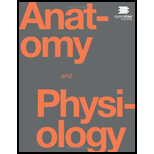
Concept explainers
Watch this video (http://openstaxcollege.org/l/2point) to see a quick demonstration of two-point discrimination. Touching a specialized caliper to the surface of the skin will measure the distance between two points that are perceived as distinct stimuli versus a single stimulus. The patient keeps their eyes closed while the examiner switches between using both points of the caliper or just one. The patient then must indicate whether one or two stimuli are in contact with the skin. Why is the distance between the caliper points closer on the fingertips as opposed to the palm of the hand? And what do you think the distance would be on the arm, or the shoulder?
Want to see the full answer?
Check out a sample textbook solution
Chapter 16 Solutions
Anatomy & Physiology
Additional Science Textbook Solutions
College Physics
Concepts of Genetics (12th Edition)
Biological Science (6th Edition)
Campbell Essential Biology with Physiology (6th Edition)
Fundamentals of Anatomy & Physiology Plus Mastering A&P with eText - Access Card Package (10th Edition) (New A&P Titles by Ric Martini and Judi Nath)
Campbell Biology (11th Edition)
- Rods differ from cones in the following ways: a. They detect dim light, not bright light. b. They have a different visual pigment. c. They are not located in the retina. d. All of the above. e. a and b onlyarrow_forward___ is defined as a decrease in the response to an ongoing stimulus. a. Perception b. Visual accommodation c. Sensory adaptiltion d. Somatic sensationarrow_forwardTwo objects with the same visual angle will always... have the same retinal image size. be at the same location. be at the same distance. have the same perceived size.arrow_forward
- Tactile acuity refers to the minimum separation required between two objects for the brain to perceive them as two separate points. The Two-Point Discrimination test is one method used to measure tactile acuity. A two-pronged instrument such as a bent paperclip is pressed at various locations on the body. The distance between the two ends is increased gradually until the person feels two distinct points. This distance is then measured. The less the distance that two points can be perceived separately, the higher the tactile acuity of that area. When comparing the tactile acuity of various body parts, what have you concluded about the number of receptors in the palm of your hand relative to the number of receptors on your shoulder? a. The tactile acuity for the palm is higher than for the shoulders. Therefore, more receptors are found on the palm than on the shoulders. b. The tactile acuity for the shoulders is higher than for the palm. Therefore, more receptors are found on the…arrow_forwardA more developed two-point tactile discrimination :-a- indicates a greater threshold distance for feeling of two points of touch applied simultaneously b- is seen in the proximal regions of the body compared with the distal regionsc- is inversely related to the size of the receptive fields of the stimulated sensory unitsd- depends upon the type of the involved touch receptorarrow_forwardWhich of the following correctly lists the steps of perception? a. Interpretation, stimulation, transduction, transmission b. Stimulation, transduction, transmission, interpretation c. Interpretation, transduction, stimulation, transmission d. Transduction, interpretation, stimulation, transmissionarrow_forward
- The most finely detailed vision occurs when an image falls on a pit in the retina called the _________.arrow_forward________ furnishes the raw material of sensory experience; ________ provides the finished product Sensation; perception Perception; sensation Sensation; transduction Perception; transductionarrow_forwardThe lowest level of stimulation that a person can consciously detect 50 percent of the time the stimulation is present is called a. absolute threshold. c. sensation. b. just noticeable difference. d. sensory adaptation.arrow_forward
- Proprioceptive sensations include all the following, except :-a- position senseb- equilibrium sensec- movement sensed- kinesthetic sensearrow_forwardWhat type of cutaneous receptor enables you to feel an insect crawling through your hair? What type enables you to palpate a patient’spulse? What type enables a blind person to read braille?arrow_forwardWhich one of the following statements about photoreception is true? a. Light detection is initiated by the absorbance of light (a photon) by a photopigment molecule. b. Light detection is synonomous with vision. c. Light detection is always initiated in a rod photoreceptor located in the retina. d. Only light in the visible range (between 400 and 700 nm wavelength) can be detected by animals. e. None of the above answer choices (neither A, nor B, nor C, nor D) is true.arrow_forward
 Anatomy & PhysiologyBiologyISBN:9781938168130Author:Kelly A. Young, James A. Wise, Peter DeSaix, Dean H. Kruse, Brandon Poe, Eddie Johnson, Jody E. Johnson, Oksana Korol, J. Gordon Betts, Mark WomblePublisher:OpenStax College
Anatomy & PhysiologyBiologyISBN:9781938168130Author:Kelly A. Young, James A. Wise, Peter DeSaix, Dean H. Kruse, Brandon Poe, Eddie Johnson, Jody E. Johnson, Oksana Korol, J. Gordon Betts, Mark WomblePublisher:OpenStax College Biology: The Unity and Diversity of Life (MindTap...BiologyISBN:9781305073951Author:Cecie Starr, Ralph Taggart, Christine Evers, Lisa StarrPublisher:Cengage Learning
Biology: The Unity and Diversity of Life (MindTap...BiologyISBN:9781305073951Author:Cecie Starr, Ralph Taggart, Christine Evers, Lisa StarrPublisher:Cengage Learning Human Biology (MindTap Course List)BiologyISBN:9781305112100Author:Cecie Starr, Beverly McMillanPublisher:Cengage Learning
Human Biology (MindTap Course List)BiologyISBN:9781305112100Author:Cecie Starr, Beverly McMillanPublisher:Cengage Learning





